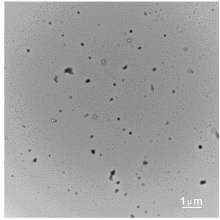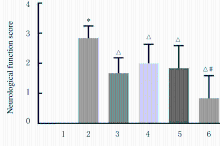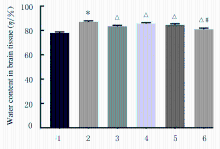| 1 |
SUN J, SHI J, HOU J, et al. Electroacupuncture protects rats from ischemic brain injury via coffilin in mice[J]. J Cell Biochem, 2020, 121(1): 43-48.
|
| 2 |
ZHAI M L, LIU C, LI Y X, et al. Dexmedetomidine inhibits neuronal apoptosis by inducing Sigma-1 receptor signaling in cerebral ischemia-reperfusion injury[J]. Aging (Albany NY), 2019, 11(21): 9556-9568.
|
| 3 |
BAZRGAR M, KHODABAKHSH P, MOHAGHEGHI F, et al. Brain microRNAs dysregulation: Implication for missplicing and abnormal post-translational modifications of tau protein in Alzheimer's disease and related tauopathies[J]. Pharmacol Res, 2020, 155: 104729.
|
| 4 |
HOU Q, RUAN H, GILBERT J, et al. MicroRNA miR124 is required for the expression of homeostatic synaptic plasticity[J]. Nat Commun, 2015, 6: 10045.
|
| 5 |
LIU X L, FENG Z T, DU L P, et al. The potential role of MicroRNA-124 in cerebral ischemia injury[J]. Int J Mol Sci, 2019, 21(1): E120.
|
| 6 |
HAMZEI TAJ S, KHO W, RIOU A, et al. MiRNA-124 induces neuroprotection and functional improvement after focal cerebral ischemia[J]. Biomaterials, 2016, 91: 151-165.
|
| 7 |
HONG W, ZHANG Z H, LIU L P, et al. Brain-targeted delivery of PEGylated nano-bacitracin A against Penicillin-sensitive and -resistant Pneumococcal meningitis: formulated with RVG29 and Pluronic® P85 unimers[J]. Drug Deliv, 2018, 25(1): 1886-1897.
|
| 8 |
潘 峰, 郭夏青, 沈江宜, 等. 大黄素对缺血性脑卒中模型大鼠的神经保护作用及其对ERK1/2信号通路的影响[J]. 吉林大学学报(医学版), 2019, 45(6): 1212-1217, 1480.
|
| 9 |
KANAZAWA T, KURANO T, IBARAKI H, et al. Therapeutic effects in a transient middle cerebral artery occlusion rat model by nose-to-brain delivery of anti-TNF-alpha siRNA with cell-penetrating peptide-modified polymer micelles[J]. Pharmaceutics, 2019, 11(9): E478.
|
| 10 |
DING D, ZHU Q. Recent advances of PLGA micro/nanoparticles for the delivery of biomacromolecular therapeutics[J]. Mater Sci Eng C Mater Biol Appl, 2018, 92: 1041-1060.
|
| 11 |
HOYOS-CEBALLOS G P, RUOZI B, OTTONELLI I, et al. PLGA-PEG-ANG-2 nanoparticles for blood-brain barrier crossing: proof-of-concept study[J]. Pharmaceutics, 2020, 12(1): E72.
|
| 12 |
CABAN-TOKTAS S, SAHIN A, LULE S, et al. Combination of Paclitaxel and R-flurbiprofen loaded PLGA nanoparticles suppresses glioblastoma growth on systemic administration[J]. Int J Pharm, 2020, 578: 119076.
|
| 13 |
GAN L, LI Z, LV Q, et al. Rabies virus glycoprotein (RVG29)-linked microRNA-124-loaded polymeric nanoparticles inhibit neuroinflammation in a Parkinson’s disease model[J]. Int J Pharm, 2019, 567: 118449.
|
| 14 |
FRÉCHOU M, ZHU X Y, LIERE P, et al. Dose-dependent and long-term cerebroprotective effects of intranasal delivery of progesterone after ischemic stroke in male mice[J]. Neuropharmacology, 2020, 170: 108038.
|
| 15 |
SUKUMAR U K, BOSE R J C, MALHOTRA M, et al. Intranasal delivery of targeted polyfunctional gold-iron oxide nanoparticles loaded with therapeutic microRNAs for combined theranostic multimodality imaging and presensitization of glioblastoma to temozolomide[J]. Biomaterials, 2019, 218: 119342.
|
| 16 |
LANDOWSKI L M, NIEGO B, SUTHERLAND B A, et al. Applications of nanotechnology in the diagnosis and therapy of stroke[J]. Semin Thromb Hemost, 2020, 46(5): 592-605.
|
| 17 |
CHUNG E P, COTTER J D, PRAKAPENKA A V, et al. Targeting small molecule delivery to the brain and spinal cord via intranasal administration of rabies virus glycoprotein (RVG29)-modified PLGA nanoparticles[J]. Pharmaceutics, 2020, 12(2): 93.
|
| 18 |
YOU L H, WANG J, LIU T Q, et al. Targeted brain delivery of rabies virus glycoprotein 29-modified deferoxamine-loaded nanoparticles reverses functional deficits in parkinsonian mice[J]. ACS Nano, 2018, 12(5): 4123-4139.
|
| 19 |
HUA H C, ZHANG X M, MU H J, et al. RVG29-modified docetaxel-loaded nanoparticles for brain-targeted glioma therapy[J]. Int J Pharm, 2018, 543(1/2): 179-189.
|
| 20 |
HASSANIPOUR M, ZARISFI M, EHSANI V, et al. Whole body hypothermia extends tissue plasminogen activator treatment window in the rat model of embolic stroke[J]. Life Sci, 2020, 256: 117450.
|
| 21 |
LIU Z J, RAN Y Y, QIE S Y, et al. Melatonin protects against ischemic stroke by modulating microglia/macrophage polarization toward anti-inflammatory phenotype through STAT3 pathway[J]. CNS Neurosci Ther, 2019, 25(12): 1353-1362.
|
| 22 |
DANIEL B, NAGY G, CZIMMERER Z, et al. The nuclear receptor PPARγ controls progressive macrophage polarization as a ligand-insensitive epigenomic ratchet of transcriptional memory[J]. Immunity, 2018, 49(4): 615-626.
|
| 23 |
FENG H X, HU L H, ZHU H W, et al. Repurposing antimycotic ciclopirox olamine as a promising anti-ischemic stroke agent[J]. Acta Pharm Sin B, 2020, 10(3): 434-446.
|
| 24 |
SHAPOURI-MOGHADDAM A, MOHAMMADIAN S, VAZINI H, et al. Macrophage plasticity, polarization, and function in health and disease[J]. J Cell Physiol, 2018,233(9): 6425-6440.
|
| 25 |
YE Y B, XU Y, LAI Y, et al. Long non-coding RNA cox-2 prevents immune evasion and metastasis of hepatocellular carcinoma by altering M1/M2 macrophage polarization[J]. J Cell Biochem, 2018, 119(3): 2951-2963.
|
| 26 |
ANRATHER J, IADECOLA C. Inflammation and stroke: an overview[J]. Neurotherapeutics, 2016, 13(4): 661-670.
|
| 27 |
ATRI C, GUERFALI F Z, LAOUINI D. Role of human macrophage polarization in inflammation during infectious diseases[J]. Int J Mol Sci, 2018, 19(6): E1801.
|
 ),Chun MA4,Shuling Li4,Xinxin LI1,Tieshu LI1
),Chun MA4,Shuling Li4,Xinxin LI1,Tieshu LI1









